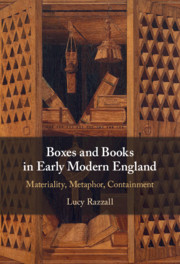Book contents
- Boxes and Books in Early Modern England
- Boxes and Books in Early Modern England
- Copyright page
- Contents
- Figures
- Acknowledgments
- A Note on Texts
- Introduction
- Chapter 1 Chests of the Mind in Early Modern England
- Chapter 2 The Renaissance of the Box
- Chapter 3 The Word in a Box
- Chapter 4 How to Read a Reliquary
- Chapter 5 ‘Because this box we know’
- Conclusion
- Bibliography
- Primary Sources
- Secondary Sources
- Index
Chapter 2 - The Renaissance of the Box
Metaphors of Interpretation
Published online by Cambridge University Press: 25 August 2021
- Boxes and Books in Early Modern England
- Boxes and Books in Early Modern England
- Copyright page
- Contents
- Figures
- Acknowledgments
- A Note on Texts
- Introduction
- Chapter 1 Chests of the Mind in Early Modern England
- Chapter 2 The Renaissance of the Box
- Chapter 3 The Word in a Box
- Chapter 4 How to Read a Reliquary
- Chapter 5 ‘Because this box we know’
- Conclusion
- Bibliography
- Primary Sources
- Secondary Sources
- Index
Summary
Turns to the metaphorical usefulness of the box, which may be troubling because its contents are unknown, unexpected or dangerous, as epitomised by Portia’s caskets in The Merchant of Venice. Bassanio is the only suitor to realise that ‘the outward shows be least themselves’. These familiar theatrical boxes signal Hamlet’s anxiety that people, things, and words might have ‘that within which passes show’.
Two such boxes are pervasive in early modern writing: Plato’s Silenus, and the proverbial apothecary’s painted box. Repeatedly invoked from Erasmus to the King James Bible, these are favourite images for the challenges of interpretation. The Silenus requires the reader to get beyond its outside to locate hidden truths. The painted box necessitates a more cautious negotiation of its exterior. Both illustrate how the crisis of hermeneutics inherent in a box – the processes required to open it, and how to discern what might be inside – materialises assumptions about the superiority of hidden things. The chapter reveals how, in its renaissance as a persistent and versatile image in early modern writing, the box itself becomes as significant as what it might or might not contain.
- Type
- Chapter
- Information
- Boxes and Books in Early Modern EnglandMateriality, Metaphor, Containment, pp. 61 - 102Publisher: Cambridge University PressPrint publication year: 2021

